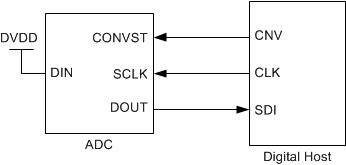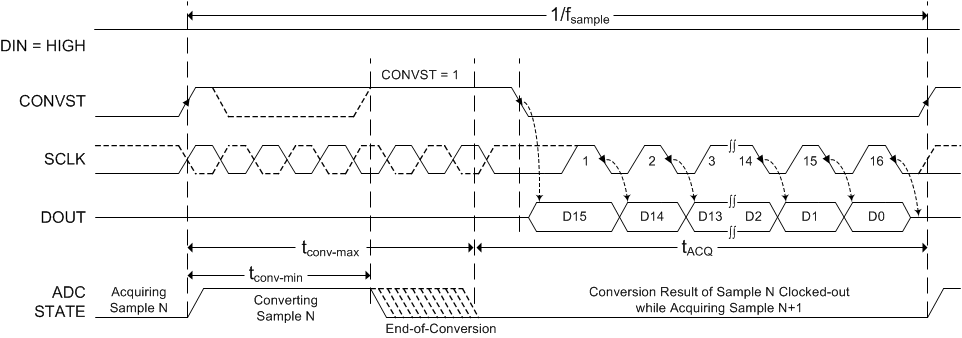ZHCSBH3C May 2013 – March 2019 ADS8866
PRODUCTION DATA.
- 1 特性
- 2 应用
- 3 说明
- 4 修订历史记录
- 5 Device Comparison Table
- 6 Pin Configuration and Functions
- 7 Specifications
- 8 Parameter Measurement Information
- 9 Detailed Description
- 10Application and Implementation
- 11Power Supply Recommendations
- 12Layout
- 13器件和文档支持
- 14机械、封装和可订购信息
封装选项
机械数据 (封装 | 引脚)
散热焊盘机械数据 (封装 | 引脚)
- DRC|10
订购信息
9.4.1.1 3-Wire CS Mode
This interface option is most useful when a single ADC is connected to an SPI-compatible digital host. In this interface option, DIN can be connected to DVDD and CONVST functions as CS (as shown in Figure 43). As shown in Figure 44, a CONVST rising edge forces DOUT to 3-state, samples the input signal, and causes the device to enter a conversion phase. Conversion is done with the internal clock and continues regardless of the state of CONVST. As a result, CONVST (functioning as CS) can be pulled low after the start of the conversion to select other devices on the board. However, CONVST must return high before the minimum conversion time (tconv-min) elapses and is held high until the maximum possible conversion time (tconv-max) elapses.
 Figure 43. Connection Diagram: 3-Wire CS Mode (DIN = 1)
Figure 43. Connection Diagram: 3-Wire CS Mode (DIN = 1)  Figure 44. Interface Timing Diagram: 3-Wire CS Mode (DIN = 1)
Figure 44. Interface Timing Diagram: 3-Wire CS Mode (DIN = 1) When conversion is complete, the device enters an acquisition phase and powers down. CONVST (functioning as CS) can be brought low after the maximum conversion time (tconv-max) elapses. On the CONVST falling edge, DOUT comes out of 3-state and the device outputs the MSB of the data. The lower data bits are output on subsequent SCLK falling edges. Data can be read at either SCLK falling or rising edges. Note that with any SCLK frequency, reading data at SCLK falling edge requires the digital host to clock in the data during the th_CK_DO-min time frame. DOUT goes to 3-state after the 16th SCLK falling edge or when CONVST goes high, whichever occurs first.